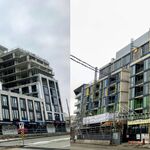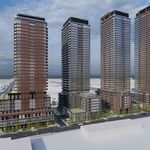just east of the creek
Active Member
Drum is spot on. Transit Priority in Toronto is the single largest issue, and if implemented, would save time on all at grade lines, regardless of whether the top speed exceeds 60 kmh or not.
I wouldn’t criticize Chow on this. She’s always been pro transit. It's a relatively low cost upgrade for the entire system, and I think she’ll get to it eventually. It’ll be the regular conservative suburban councillors who’ll find a way to put the kibosh on it.It’s wild to me that it’s not - and that no one at City Hall seems to care.
Incredibly disappointing from this Mayor and Council.
yea i dont think she even knows about this issue. she only came in last year and all these operation speeds were determined long before tory stepped down.I wouldn’t criticize Chow on this. She’s always been pro transit. It's a relatively low cost upgrade for the entire system, and I think she’ll get to it eventually. It’ll be the regular conservative suburban councillors who’ll find a way to put the kibosh on it.
I do think she’s probably very hands-on with transit, cycling and pedestrian needs. If anything, I think she’s just being incrementalist and diplomatic about her goals and not pushing everything at once.yea i dont think she even knows about this issue. she only came in last year and all these operation speeds were determined long before tory stepped down.
what we need to do is raise awareness to her office so that her staff can bring it up to her.
BRT vs LRT will always see BRT coming out cheaper than LRT on capital cost, but loose that advantage in operation cost and life cycle. It also loose on the quality of ride.
If BRT is running in mixed traffic or a traffic lane, it doesn't have to cover the cost to maintain the road as well being subject to rough road ride compare to an LRT that does the same thing, but pay full cost for that lane.
Do the math as to how many riders will be on the line per hour and divided that number by an articulated bus carrying capacity to see how many buses you will need. Then multiply that bus number by 3.5 that will represent the number of drivers. You need to see how many buses will be needed for a 30 year life cycle along with the cost to buy them.
As to doing the math for LRT, you need to do the same thing, but decide the length of the LRV to see how many you will need as step 1 to compare apples to apples. Step 2 will see if you can run one LRV or up to 3 as it mean a reduction in the number of drivers which happens to be the most expensive item for operation cost.
In a true comparison of apples to apples using a true ROW for both systems, LRT will be the winner over a 30 year life cycle that includes the construction cost. In a mixed cycle, the LRT still come out ahead, but not much.
But the Spadina streetcar is probably the best example of an “LRT” having way too many stops and being super slow.Yes, she is hands on. I lived in the Annex in the 90s and recall that she was personally responsible for adding back in some of the stops on the Spadina car the TTC wanted to eliminate.
But the Spadina streetcar is probably the best example of an “LRT” having way too many stops and being super slow.

Ah I see. My point was that not that the cars wouldn't operate at 80 - but that they would operate at 80 over the majority of their duty cycle which I saw as different from operating at that speed more slowly over much of it. One of the frequently heard complaints about ION is that the nature of the alignment doesn't allow the cars to operate at design speed over much of its length.Ottawa uses a different type of car as this line.
As we've discussed frequently, Waterloo uses the same cars, and they've been in service there for years.
There is a thread for this, but Anyhow,...Lots of new detail on the Eglinton East LRT here:

Eglinton East LRT: Public Consultation
For Phase Two Public Consultations, Public Drop-In Events were held on May 29, May 30 and June 1, 2024 that included an opportunity to speak with project staff and view project information panels. View the Phase Two Public Consultation Report below.www.toronto.ca
Are you joking? 27 stops over 18 km is about a 700 m stop spacing. Finch West is 600 m, and Line 1 and 2 downtown are even shorter.There is a thread for this, but Anyhow,...
27 stops...? No wonder the thing is gonna be slower than the bus. There is no way that many stops are necessary today or in any realistic future. I would not be shocked if an elevated line would be cheaper since It'd have only a third of these.
I'm not going to address the comparison to Line 1 downtown because it's self-evidently apples and steak. We are in the burbs. Still, for Finch, the case is much clearer; demand exists, and the trip generators are in place (straight along Finch). This is all conjecture though; further unlike Finch, most of the connections for this line don't exist yet. We have no idea what demand will be like to or from them.Are you joking? 27 stops over 18 km is about a 700 m stop spacing. Finch West is 600 m, and Line 1 and 2 downtown are even shorter.
It's not like anyone will ever ride the whole thing in one shot, other than a few fanatics.
Streetcars built Toronto, LRT can do the same thing for areas that need to grow while buses will not. PPL prefer steel rail over rubber wheels for a smoother ride. Then there is the operation cost for both systems with LRT winning so long it not underground.I'm not going to address the comparison to Line 1 downtown because it's self-evidently apples and steak. We are in the burbs. Still, for Finch, the case is much clearer; demand exists, and the trip generators are in place (straight along Finch). This is all conjecture though; further unlike Finch, most of the connections for this line don't exist yet. We have no idea what demand will be like to or from them.
here's my angle, it's nothing new. While on the one hand, I understand that this is meant for local trips, on the other we aren't exactly building a cheap Parisian tramway. This is going to cost a lot, and its worth asking if this is the best use of the money for rail transit specifically. As for determining the best mode... if this is to be for local travel, I'm not convinced there is enough demand to justify LRT over BRT. But if alot of demand is coming from connections, then both might fail at moving people quickly enough. The mode choice seems to be a recognition of that, but completely compromises the network utility that could exist for most subway riders. GO riders have a better prospect here I'll admit.
Rapid Transit here is a good idea, don't get me wrong; this simply doesn't seem the best way to do it for those nearby or city-wide. For instance, I am not sold on this being a great deal for connecting Malvern, but admittedly I am not from the area so I can't say for certain.
In brief... you/we need to look at the tradeoffs here. The province certainly has...




